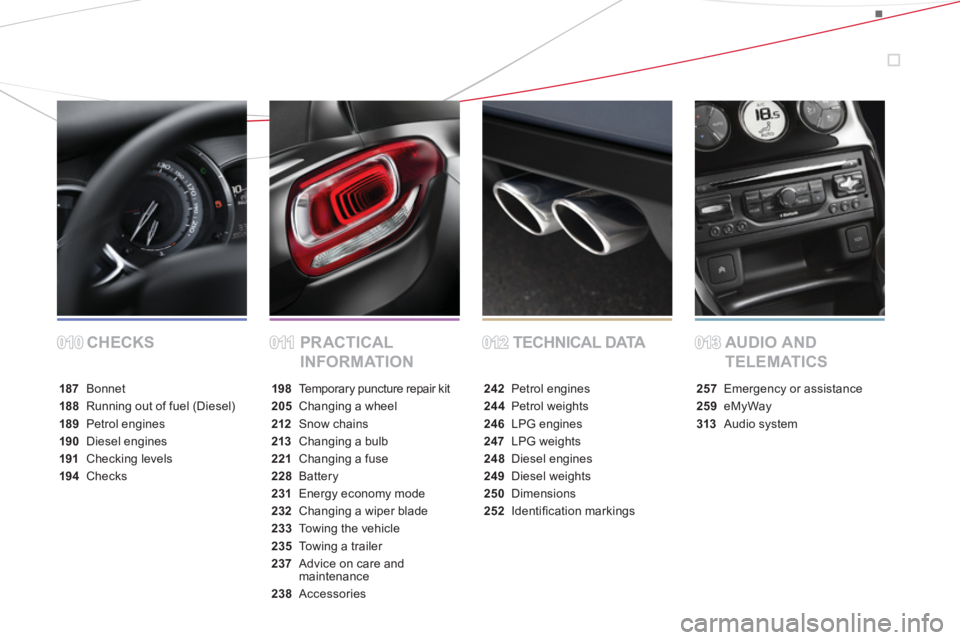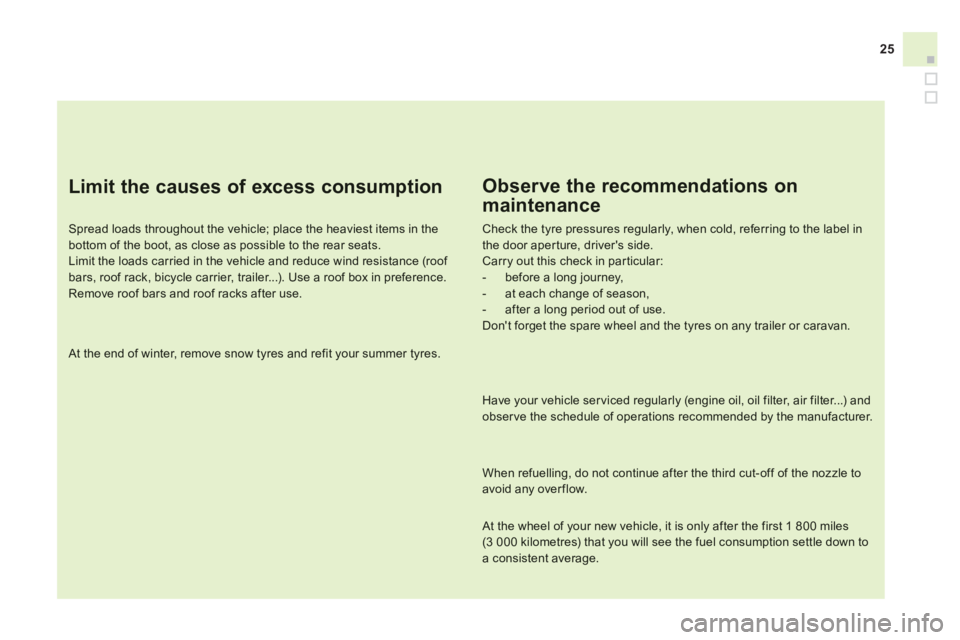trailer CITROEN DS3 CABRIO DAG 2014 Handbook (in English)
[x] Cancel search | Manufacturer: CITROEN, Model Year: 2014, Model line: DS3 CABRIO DAG, Model: CITROEN DS3 CABRIO DAG 2014Pages: 384, PDF Size: 11.84 MB
Page 7 of 384

CHECKS PRACTICAL
INFORMATIONTECHNICAL DATA AUDIO AND
TELEMATICS
187 Bonnet
188 Running out of fuel (Diesel)
189Petrol engines
190Diesel engines
191Checking levels
194 Checks
198Temporary puncture repair kit
205 Changing a wheel
212Snow chains
213 Changing a bulb
221Changing a fuse
228Battery
231Energy economy mode
232Changing a wiper blade
233Towing the vehicle
235 To w i ng a trailer
237 Advice on care andmaintenance
238Accessories
242 Petrol engines
244Petrol weights
246 LPG engines
247LPG weights
248 Diesel engines
249 Diesel weights
250 Dimensions
252Identifi cation markings
257Emergency or assistance
259eMyWay
313 Audio system
012012013013010010011011
Page 27 of 384

25
Limit the causes of excess consumption
Spread loads throughout the vehicle; place the heaviest items in the bottom of the boot, as close as possible to the rear seats.
Limit the loads carried in the vehicle and reduce wind resistance (roof bars, roof rack, bicycle carrier, trailer...). Use a roof box in preference.
Remove roof bars and roof racks after use.
At the end of winter, remove snow tyres and refit your summer tyres.
Observe the recommendations on
maintenance
Check the tyre pressures regularly, when cold, referring to the label inthe door aperture, driver's side.
Carry out this check in par ticular:
- before a long journey,
- at each change of season,
- after a long period out of use.
Don't forget the spare wheel and the tyres on any trailer or caravan.
Have your vehicle ser viced regularly (engine oil, oil filter, air filter...) andobser ve the schedule of operations recommended by the manufacturer.
When refuelling, do not continue after the third cut-off of the nozzle toavoid any over flow.
At the wheel of your new vehicle, it is only after the first 1 800 miles (3 000 kilometres) that you will see the fuel consumption settle down toa consistent average.
Page 185 of 384

183Driving
ProgrammingOperating faults
If there is an operating fault, when
reverse gear is engaged this warning lamp comes on in the instrument panel, accompanied by an audible signal (short beep)and a message in the multifunction screen. You can activate or deactivate the s
ystem bymeans of the multifunction screen configuration menu. The system state is memorised when
switching off the ignition.
For more information on access to the parkingsensors menu, refer to "Vehicle configuration"
or "Vehicle parameters" section for your multifunction screen.
The system will be deactivated automatically when towing a trailer or when a bicycle carrier is fitted (vehiclefitted with a towbar or bicycle carrier recommended by CITROËN).
In bad or wintry weather, ensure that the sensors are not covered with mud,frost or snow.
Page 225 of 384

223Practical information
Fuse N°RatingFunctions
F820 AMultifunction screen, audio system, navigation radio, alarmcontrol unit, alarm siren.
F
930 A12 V socket, portable navigation suppor t supply.
F10 15
ASteering mounted controls.
F1
115 AIgnition, diagnostic socket, automatic gearbox control unit.
F1
215 ARain / sunshine sensor, trailer relay unit.
F1
35 AMain stop switch, engine relay unit.
F1415 AParking sensors control unit, airbag control unit, instrument panel, digital air conditioning, USB Box, Hi-Fi amplifier.
F15
30 ALocking.
F1
6-Not used.
F1740 ARear screen and door mirrors demisting/defrosting.
S
H-PA RC shunt.
Page 237 of 384

Practical information
Towing a trailer
Towbar suitable for the attachment of a trailer
with additional lighting and signalling.
We recommend the use of genuineCITROËN towbars and their harnesses that have been tested and approved from the design stage of your vehicle, and that the fitting of the towbar is entrusted to a CITROËN dealer or a qualified workshop.If the towbar is not fitted by a CITROËNdealer, it is imperative that it is fitted in accordance with the vehicle manufacturer's instructions.
Driving with a trailer places greater demands
on the towing vehicle and the driver must take par ticular care.
Driving advice
Distribution of loads
�)
Distribute the load in the trailer so that the heaviest items are as close as possible to
the axle and the nose weight approaches the maximum permitted without exceeding it.
Air density decreases with altitude, thus
reducing engine per formance. Above
1 000 metres, the maximum towed load must
be reduced b
y 10 % for every 1 000 metres of altitude.
Side wind
�)
Take into account the increased sensitivity
to side wind.
Your vehicle is primaril
y designed for
transporting people and luggage, but it mayalso be used for towing a trailer. R
efer to the "Technical Data" section for detailsof the weights and towed loads which apply to your vehicle.
Page 238 of 384

RACING towbar
Your vehicle cannot be fitted with a towbar. The space occupied by thesport diffuser prevents this.
Tyres
�)
Check the tyre pressures of the towing
vehicle and of the trailer, obser ving the
recommended pressures.
Cooling
Towing a trailer on a slope increases the
temperature of the coolant.
As the fan is electrically controlled, its coolingcapacity is not dependent on the engine speed. �)To lower the engine speed, reduce your
speed.
The maximum towed load on a long incline depends on the gradient and the ambient
temperature.
In all cases, keep a check on the coolant
temperature.
Braking
To w i ng a trailer increases the braking distance.
To avoid overheating of the brakes on a longmountain type of descent, the use of engine
braking is recommended.
Lighting
�)
Check the electrical lighting and signallingon the trailer.
The rear parking sensors will bedeactivated automatically if a genuineCITROËN towbar is used.�)
If the warning lamp and the
STOPwarning lamp come on,
stop the vehicle and switch off
the engine as soon as possible.
Page 242 of 384

012
Technical data
This section contains the specifications of your vehicle depending on itsengine and gearbox, such as the maximum power and torque, unladenand maximum weights, trailer weights, exterior dimensions and all of its
identification markings.
Page 246 of 384

*For Belgium and Russia. **
For Brazil.***
The weight of the braked trailer can be increased, within the GTW limit, if the GVW of the towing vehicle is reduced by an equal amount. Warning:
towing using a lightly loaded towing vehicle may have an adverse effect on its road holding.
.../S: e-VTi model fitted with Stop & Start.
The GTW and towed load values indicated are valid up to a maximum altitude of 1 000 metres; the towed load mentioned must be reduced by 10 % for each additional 1 000 metres of altitude.
The speed of a towing vehicle must not exceed 60 mph (10 0 km/h) (comply with the legislation in force in your country).
High ambient temperatures may result in a reduction in the per formance of the vehicle to protect the engine; if the ambient temperature is above 37 °C,
limit the towed load.
WEIGHTS AND TOWED LOADS (in kg)
Petrol enginesVTi 82e-VTi 82VTi 95VTi 120THP 155THP 150*THP 160
**
GearboxesManualElectronicElectronicManualAutomaticManual
Model codes: SA...HMZ0HMZ0/PS8FR08FP05FS05FS95FV85FN8*5FM8**
- Unladen weight
975
980 1 079 1 075
1 089 1 090
-
Kerb weight
1 050
1 0551 1541 150
1 164
1 165
- Gross vehicle wei
ght (GV W)
1 4961 523
1 558
1 554 1 587 1 590
-
Gross train weight (GTW) on a 12 % gradient
2 296
2 323
2 458
2 454
2 487 2 490
- Braked trailer
(within the GTW limit) on a 12 % gradient 800
800
900
900
900900
- Braked trailer *** (with load transfer within
the GTW limit)1 100
1 1001 1501 150
1 150
1 150
-
Unbraked trailer
520
520
570
570
570570
-
Recommended nose weight
46
46
46
46
46
46
Page 247 of 384

245
Technical data
WEIGHTS (in kg)- RACING
Petrol engine
GearboxManualManual
Model codes: SA...5FF85FD8
- Unladen weight 1 165
- Kerb weight 1 240
-
Gross vehicle weight (GVW)
1 597
-
Gross train weight (GTW)
on a 12% gradient 1 597
- Braked trailer
(within the GTW limit)
on a 12% slop0
- Braked trailer (with transfer of load within
the GTW limit)0
- Unbraked trailer 0
- Recommended nose wei
ght *0
*
See the "Towing a trailer" section.
Page 249 of 384

247Technical data
*
The weight of the braked trailer can be increased, within the GTW limit, if the GVW of the towing vehicle is reduced by an equal amount; warning,
towing using a lightly loaded towing vehicle may have an adverse effect on its road holding.
WEIGHTS AND TOWED LOADS (in kg)
LPG enginesVTi 95
GearboxManual
Model codes:SA...8FR0/GPL
-
Unladen weight 1 152
- Kerb wei
ght 1227
- Gross vehicle weight (GV W)
1 552
-
Gross train weight (GTW)
on a 12 % slope
2 452
- Braked trailer
(within GTW limit) on a 12 % slope 900
- Braked trailer *
(with load transfer within the
GTW limit) 1 15 0
- Unbraked trailer
570
-
Recommended nose weight 46
The GTW and towed load values indicated are valid up to a maximum altitude of 1 000 metres; the towed load mentioned must be reduced by 10 % for each additional 1 000 metres of altitude.
The speed of a towing vehicle must not exceed 60 mph (10 0 km/h) (comply with the legislation in force in your country).
High ambient temperatures may result in a reduction in the per formance of the vehicle to protect the engine; if the ambient temperature is above 37 °C,
limit the towed load.